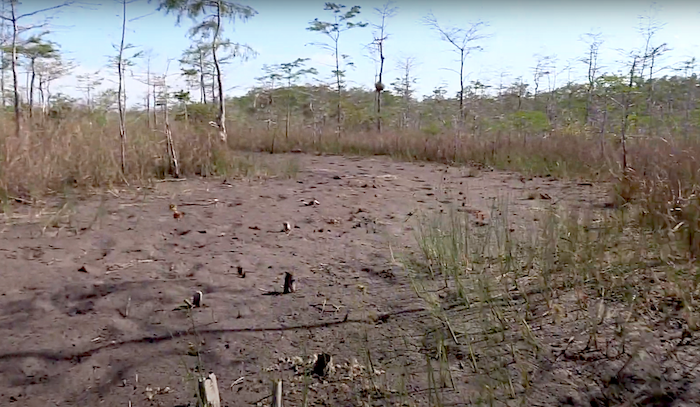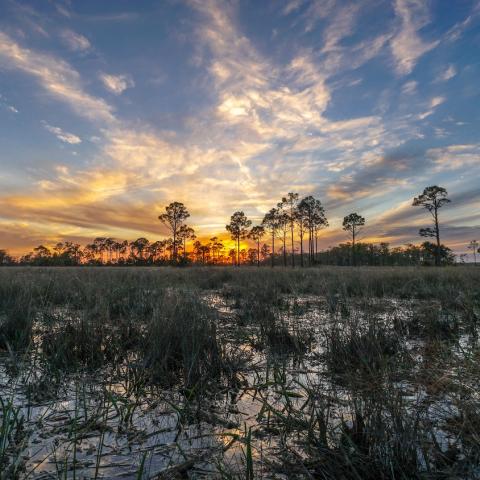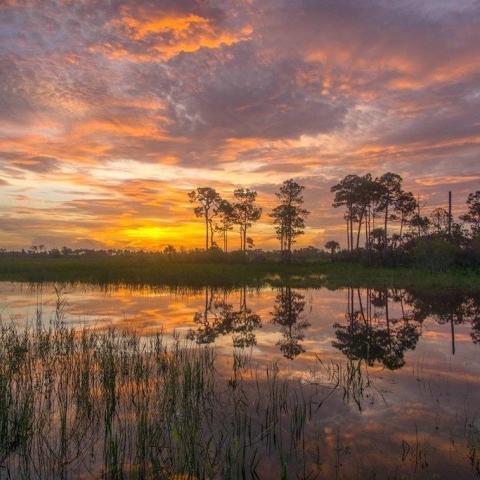Six years after an oil company trudged out across Big Cypress National Preserve with ponderous “vibroseis” trucks that can weigh 30 tons apiece to search for oil reserves, ruts still ramble across the marl prairie, native vegetation is disrupted, and cypress tree revegetation appears to have stagnated.
National Park Service staff sound mostly satisfied with Burnett Oil Co.'s efforts to restore the sensitive landscape, but an analysis of present-day conditions by the National Parks Conservation Association points to remaining scars gouged by the vibroseis trucks, channelized areas that interfere with the flow of the "river of grass" towards Florida Bay, and "almost zero natural regrowth where bald cypress trees were cut down by the oil company."
"We believe that we need to elevate the message that Big Cypress needs to be properly restored, and it needs to be fully safeguarded from future oil development," Melissa Abdo, NPCA's Sun Coast regional director and author of Speaking Up For The Swamp, Revealing Persistent Oil And Gas Impacts In Big Cypress National Preserve.
"It's unacceptable that here we are today, on the eve of the 50th anniversary of the preserve, and more than six years after those devastating oil explorations occurred in the preserve, and yet there has been no authentic attempt at making habitat restoration happen that's been made by the Park Service," she continued during an appearance on this week's podcast from the National Parks Traveler. "And there has not been a full enough attempt to hold the oil company accountable to the clearly defined conditions that were laid out in the National Park Service permit that authorized that hunt for oil that occurred back in 2017 and 2018."
Burnett put its plans to drill for oil on hold in 2022 when the Park Service decided a more thorough environmental impact statement needed to be prepared on the company's proposal to drill horizontally beneath the preserve from sites just outside Big Cypress's borders.
America's First National Preserves
A half-century ago, on October 11, 1974, the "national preserve" category became part of the National Park System lexicon with the additions of Big Cypress in South Florida and Big Thicket in southeastern Texas. Though part of the park system, national preserves allow "for a certain level of resource extraction like hunting and fishing," or, in the case of both Big Cypress and Big Thicket, oil extraction.
At Big Cypress, the preserve is a "split estate" — while the National Park Service owns the surface rights, oil deposits underground are privately owned and can be developed in certain cases, though with stringent conditions aimed at protecting the above-ground natural resources. And Big Cypress showcases incredible resources.
There are 30 species of orchids within its borders, including the rare Ghost orchid, one of the most famous flowers in Florida, but one whose population has declined by more than 90 percent globally. Rare woodpeckers that live in family groups, with youngsters helping to raise their siblings, make Big Cypress home. So does a subspecies of panther (listed as an endangered species more than five decades ago) that has tenaciously survived despite the steady urbanization of Florida, and the Everglades dwarf siren, a curious, bushy-gilled salamander that can grow up to 10 inches long.
Abdo grew up near Big Cypress, and one of her first jobs involved cataloguing all the vegetative species in the preserve for the Park Service.
"So through that work, I got to know the preserve very well. And of course, I've really appreciated not only the plant life, but all the wildlife and biodiversity in the preserve and the vital role it plays in the western Everglades ecosystem," she said.
Covering more than 720,000 acres, the preserve is home to a menagerie of wildlife. Wood storks, an endangered species, live in Big Cypress, as do the red-cockaded woodpecker (endangered), the Everglade snail kite (endangered), Audubon’s Crested Caracara (threatened), the Eastern Indigo snake (threatened), and the American alligator (threatened). The preserve also provides important habitat to numerous other rare and federally endangered species of plants, birds, bats, and butterflies. The state of Florida, meanwhile, lists nearly 70 plant species within Big Cypress as endangered, and if you include threatened species, the state’s tally reaches 100 for the preserve.

Cardinal airplants, epiphytes, are listed as endangered by the state of Florida. They anchor themselves to dwarf cypress trees in Big Cypress/Kurt Repanshek file
The vegetation can be breathtaking when it's in bloom.
"You can kind of imagine some of the iconic tropical plants like orchids and Bromeliads that make their homes in those deep swamp water habitats," said Abdo.
The preserve takes its name from cypress trees, and there are two that grow there: the dwarf cypress and the taller bald cypress.
"You can see tall towering ones, say, in a cypress dome habitat, and those might even have bromeliad species, neat species of air plants that are living on them," said Abdo. "It's not a parasitic relationship, it's a symbiotic relationship. You can experience cypress trees with air plants growing on them, or even a butterfly orchid. You might spot a dwarf cypress tree in a marl prairie that has a butterfly orchid growing on it."
Just as precious as Big Cypress is for wildlife, it's equally precious for its water. Located adjacent to Everglades National Park and to its north, Big Cypress is a conduit for the "river of grass" that flows south from Lake Okeechobee to Florida Bay. As such, changes to the preserve's topography can impact that flow by diverting it off its natural course or damming the flow.
"The hydrology and the flow of water across the preserve is of vital importance to the entire Greater Everglades ecosystem," explained Abdo. "We know that Big Cypress provides more than 40 percent of the water flows that eventually make their way into Everglades National Park, and then, of course, into surrounding estuaries in southwest Florida."
The Impacts
The Park Service is well aware of the impacts oil exploration can have on Big Cypress. In 2016, when it issued the exploration permit to Burnett Oil, the agency attached a list of nearly four dozen mitigation requirements the company was expected to meet.
Among those mitigations were the following specific to ground and vegetation disturbances:
- Vibroseis buggies will be equipped with wide, smooth treaded balloon tires to spread the buggy weight over a wider “footprint” to reduce soil impacts and rutting.
- Seismic survey activities will generally utilize a "one pass" design for Vibroseis equipment groups, which will greatly reduce potential short-term impacts. The "one pass" survey design means that the equipment group (which will include a UTV and three Vibroseis buggies) will seek to traverse a given area only once.
- Vibroseis source lines will be located on existing roads, trails and disturbances, where feasible.
- Low shrubs and herbaceous vegetation, topsoil, rootstock, and plant material will be left in place along source lines, receiver lines, and access routes to facilitate natural re-vegetation. Also, marred or wounded standing trees will be treated with a commercially available, non-toxic pruning paint or wound coating.
- Ruts, depressions, and vehicle tracks resulting from field operations will be restored to original contour conditions concurrent with daily operations using shovels and rakes to prevent the creation of new trails. Field clean-up activities will begin immediately upon completion of each task, and final clearance will be documented by and coordinated with NPS inspectors to the satisfaction of the Superintendent.
- Where vegetative trimming is required, areas with native vegetation will be avoided if trimming areas with exotic vegetation can accomplish an acceptable positioning of vibration or receiver points.
- Trimming native vegetation below the height or beyond the width of 36 inches or with a 4-inch or greater trunk diameter as measured at breast height will be avoided.
- All adverse impacts to wetlands resulting from any project actions, including rutting and compaction of soils and/or destruction of vegetation from vehicle use, will be identified by NPS staff. Field reclamation of impacts will begin immediately as the survey continues. Soils will be decompacted and returned to match the original grade. If the NPS determines that revegetation of the disturbed areas is necessary, then the area will be identified and BOCI will plant native species in a specific pattern, species composition, and density as defined by the NPS.
- Restoration activity will occur during the dry season and may include the use of mechanical or hand equipment to loosen the soil and level soil ruts to existing natural grade of adjacent undisturbed areas. Revegetation will be allowed to occur via natural recruitment unless planting is required by the NPS.
- As compensation for any temporal loss of wetland function resulting from vehicle use documented by the NPS, an equivalent area of wetland restoration area will be conducted elsewhere in the Preserve as identified by the NPS to offset the specific functional loss identified by the NPS. BOCI will restore an area providing wetland functional benefit equivalent to the wetland functional loss documented by the NPS from the project. The soils will be decompacted and returned to match original grade as directed by the NPS. If the NPS determines that revegetation of the disturbed areas is necessary, then the area will be identified and BOCI will plant native species in a specific pattern, species composition, and density as defined by the NPS.
While NPCA's report claims both Burnett Oil and the Park Service have failed in living up to these standards, Big Cypress staff told the Traveler they were generally satisfied with the work that has been done.
"The National Park Service is continuing to evaluate the results of ongoing monitoring of environmental recovery within the seismic survey operations area as required by Burnett Oil Co., Inc.’s permit for the survey within Big Cypress National Preserve," Scott Pardue, the preserve's public information officer, said in an email. "Reclamation of the operations area, which is separate from the compensatory wetland mitigation requirement, is complete and is currently being monitored annually by a Burnett contractor with oversight by NPS and the state. Recovery appears to be on track. However, the effectiveness of the reclamation, the trajectory of recovery to date, and the sufficiency of mitigation approved by NPS continue to be evaluated."

While this photo was taken in March 2020, NPCA maintains similar settings remain in Big Cypress today/Kurt Repanshek file
NPCA takes strong exception to that perspective. The Speaking Up For The Swamp report pointed out that while the list of mitigations the Park Service attached to Burnett's permit called for daily restoration efforts to, essentially, erase the tracks laid down by the vibroseis vehicles and see that the natural topography was restored, in some places "[D]iscrepancies in water depths between the seismic-impacted and undisturbed areas ranged from 0 to 8 inches, averaging at 2.85 inches."
"The beautiful trees that are the preserve's namesake trees, the cypress trees, have not shown signs that they're going to come back," Abdo said during the podcast. "We're talking almost zero regeneration in those damaged areas. So if the Park Service is stating that reclamation is complete, what we have observed in a portion of the seismic-damaged area, the area where oil hunt took place, if we just look at the cypress trees alone, what we're observing indicates otherwise. It shows clearly that, at the bare minimum, the company should be responsible for replanting the cypress tree directly in the areas they damage, because they're not coming back naturally."
Politics
It's been said in conservation circles that Big Cypress is a "sacrificial lamb" of the National Park System. Through the decades a number of decisions appear curious when placed in context to the Park Service's overarching mission to "... conserve the scenery and the natural and historic objects and the wild life therein and to provide for the enjoyment of the same in such manner and by such means as will leave them unimpaired for the enjoyment of future generations." Past decisions on wilderness designation and oil exploration in the preserve have gone against that mission.
Prior to the 2016 decision to allow Burnett Oil to search for oil was the Park Service's decision to conduct an environmental assessment as opposed to a more intensive environmental impact statement on the company's request to conduct the exploration work.
In 2015 there was an assessment of wilderness quality lands in the preserve that proposed to open lands closed to ORV trails by a 2000 off-road management plan. That plan had cut 23,300 miles of dispersed ORV trails in the preserve down to just 400 miles of designated trails. In greatly reducing the miles of ORV trails, then-Superintendent John Donahue based his decision on biological information and suitability studies indicating that ORVs were damaging ecosystems and disturbing the Florida panther, an endangered species.
Six months later, early in 2016, a backcountry access management plan proposed by the preserve staff called for an increase in ORV trails in all but one of the preliminary alternatives while holding non-motorized trails somewhat static. The one alternative that didn't increase ORV use? It called for preserving the status quo.
There also was the time back in 2011 when the preserve staff decided not to take the "environmentally preferred" alternative when crafting a wilderness plan for "the Additional lands," a 147,000-acquire parcel the Park Service obtained from the state of Florida as part of a land swap. The NPS approved the preferred alternative -- which the agency acknowledged would "maximize motorized access, provide the least amount of wilderness, and develop limited new hiking only trails" -- despite criticism from the U.S. Environmental Protection Agency, members of Congress, and conservation groups.
More recently, the U.S. Army Corps of Engineers in 2020 did a 180-degree flip on whether the Corps needed to closely monitor Burnett's exploration efforts.
On March 6 of that year Robert Halbert, the Corps' chief of compliance and enforcement in the Jacksonville, Florida, district, wrote Burnett Oil Co. President Charles Nagel to say the exploration work was in fact “mechanized land clearing, ditching and channelization,” activities that “caused an impact that resulted in a change in the bottom elevation of the wetland, that the activity caused an identifiable individual and cumulative adverse effect on aquatic function, and that the survey had the adverse effect of degrading a water of the U.S.”
Furthermore, Halbert told Nagel that the company would have to coordinate any future survey work “with the Corps in accordance with the Clean Water Act. A permit will be required of you unless and until you can demonstrate to the satisfaction of the Corps or Environmental Protection Agency, prior to commencing the activity involving the discharge, that the activity would not have the effect of destroying or degrading any area of waters of the United States.”
But just weeks later that directive was lifted by Col. Andrew D. Kelly, Jr., the Corps' Jacksonville district commander, who reached his decision after talking with Big Cypress staff.
"Jacksonville District rescinds the conclusions specified in the previous letter and asserts no further action is being taken by Jacksonville District or required of Burnett for its completed seismic survey," the colonel wrote in a letter to Nagel. "Given the environmental sensitivity in the Big Cypress National Preserve and your expressed commitment to environmental stewardship, Jacksonville District looks forward to working with you on any future actions to clearly and transparently identify and take the appropriate action on any regulatory requirements and communicate in a professional manner as we aspire to do with every potential applicant."
Whether NPCA's report changes the Park Service's conclusions on Burnett's reclamation work remains to be seen.
"We have not yet received the Park Service's response [to the report's findings]," said Abdo. "We'd really love to understand their response and have a constructive dialogue that results in a good outcome for the preserve. That's really what's at the heart of all this."
Traveler postscript: Listen to this week's podcast with NPCA's Melissa Abdo.






 Support Essential Coverage of Essential Places
Support Essential Coverage of Essential Places







Add comment